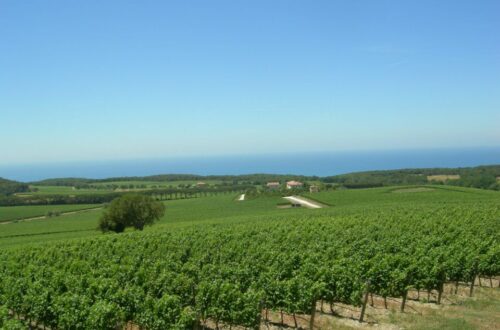1. What is Lambrusco Salamino di Santa Croce DOC?
Lambrusco Salamino di Santa Croce DOC is one of Modena’s most distinctive sparkling reds, made primarily from the Lambrusco Salamino grape — named for its small, salami-shaped clusters. Unlike its more widely known cousins from Sorbara or Grasparossa, Salamino di Santa Croce offers a harmonious balance between lively acidity and deep fruit character, with a refined mousse that makes it equally at home at a trattoria table or a Michelin-starred dining room.
2. History and Origins
The Lambrusco family of grapes has been cultivated in the Emilia-Romagna region since Roman times, praised by poets like Virgil for their vigor and perfume. The Salamino variety likely emerged from natural crossbreeding among ancient Lambrusco types, thriving in the fertile plains north of Modena. The DOC was officially established in 1970, protecting a tradition deeply tied to local culture — from winter feasts to summer aperitivi.
3. Where It’s Made: Geography & Terroir
The production zone sits in the flat, alluvial plains around the town of Carpi, north of Modena. Here, sandy and silty soils, combined with the Po Valley’s temperate continental climate, produce grapes with bright aromatics and natural freshness. Morning mists, warm days, and cool nights during the ripening season help preserve acidity while allowing the fruit to develop generous berry notes.
4. The Grape
Lambrusco Salamino gets its name from the shape of its grape clusters, resembling small salamis. The variety is prized for its intense violet aroma, crisp acidity, and concentrated color. While it can produce structured wines, its charm lies in the balance between fruit-forward exuberance and refined tannins, making it a versatile choice for both secco (dry) and amabile (semi-sweet) styles.
5. Winemaking & DOC Regulations
By DOC law, Lambrusco Salamino di Santa Croce wines must contain at least 85% Lambrusco Salamino, with up to 15% of other approved Lambrusco varieties or Ancellotta. The wines are typically made using the Charmat (tank) method for freshness and aromatic purity, though some artisanal producers are experimenting with the traditional method for added complexity. Styles range from still to frizzante (lightly sparkling) and spumante (fully sparkling), with varying sweetness levels.
6. Key Facts at a Glance
| Fact | Details |
| DOC Status | Since 1970 |
| Region | Emilia-Romagna, Italy |
| Primary Grape | Lambrusco Salamino (min. 85%) |
| Styles | Still, frizzante, spumante; secco to amabile |
| Typical ABV | 10–11.5% |
| Serving Temp | 10–12°C (50–54°F) |
| Best Glassware | Tulip-shaped sparkling wine glass |
7. Tasting Notes
A good Lambrusco Salamino di Santa Croce DOC greets you with a vivid ruby-red hue and a persistent, fine mousse. Aromas often suggest fresh cherries, wild strawberries, violets, and a whisper of baking spice. On the palate, expect bright acidity, gentle tannins, and a playful sparkle that cleanses the mouth — making it dangerously drinkable.
8. Serving & Pairing
The wine’s freshness and moderate alcohol make it a dream with Emilia-Romagna’s rich cuisine. Think:
- Tortellini in brodo – the bubbles cut through the broth’s richness.
- Gnocco fritto with cured meats – a Modenese classic.
- Parmigiano Reggiano – the region’s other great pride.
- For adventurous pairings: spicy Asian stir-fries or barbecue ribs benefit from its fruity sparkle.
9. Where to Buy & Pricing
Lambrusco Salamino di Santa Croce DOC offers excellent value, with most bottles retailing for $12–20 internationally. Look for quality producers like:
- Cantina di Carpi e Sorbara
- Chiarli
- Paltrinieri
- Bellei
Special cuvées may fetch higher prices, especially from artisanal growers working with low yields.
10. FAQ
Is Lambrusco Salamino di Santa Croce sweet?
Not necessarily — it can be dry (secco), off-dry (semisecco), or semi-sweet (amabile).
How does it compare to Lambrusco di Sorbara?
Sorbara tends to be lighter and more floral, while Salamino di Santa Croce is fuller-bodied with deeper fruit notes.Can it age?
While best enjoyed young for freshness, some structured dry examples can develop complexity over 2–3 years.
11. Fun Facts & Cultural Notes
- The town of Santa Croce hosts a yearly Lambrusco festival, where producers pour directly from chilled tanks.
- Locals often serve Salamino with a zampone (stuffed pig’s trotter) during winter holidays.
- Its brilliant foam has inspired painters and photographers documenting Emilia’s wine traditions.
Internal Linking Suggestions (Drink Italian)
- Link “Emilia-Romagna” to your Emilia-Romagna wine region guide.
- Link “Lambrusco” to your general Lambrusco article.
- Link “Parmigiano Reggiano” to your Emilia-Romagna food and wine pairings article.
External Linking Suggestions
- Italian Wine Central – Lambrusco Salamino di Santa Croce DOC profile.
- Consorzio Tutela Lambrusco di Modena official site.


